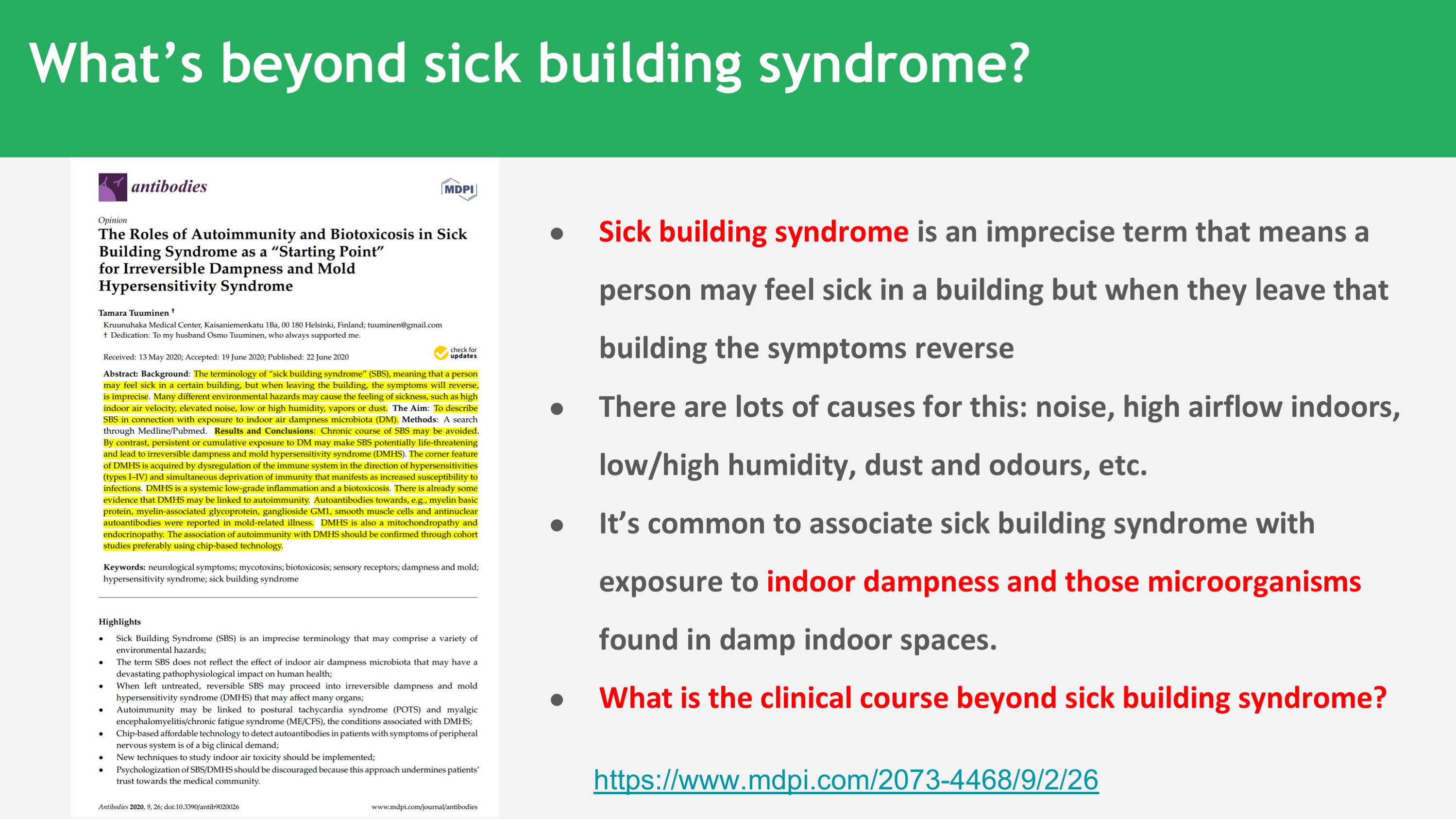What Is Dampness and Mould Hypersensitivity Syndrome, Anyway?
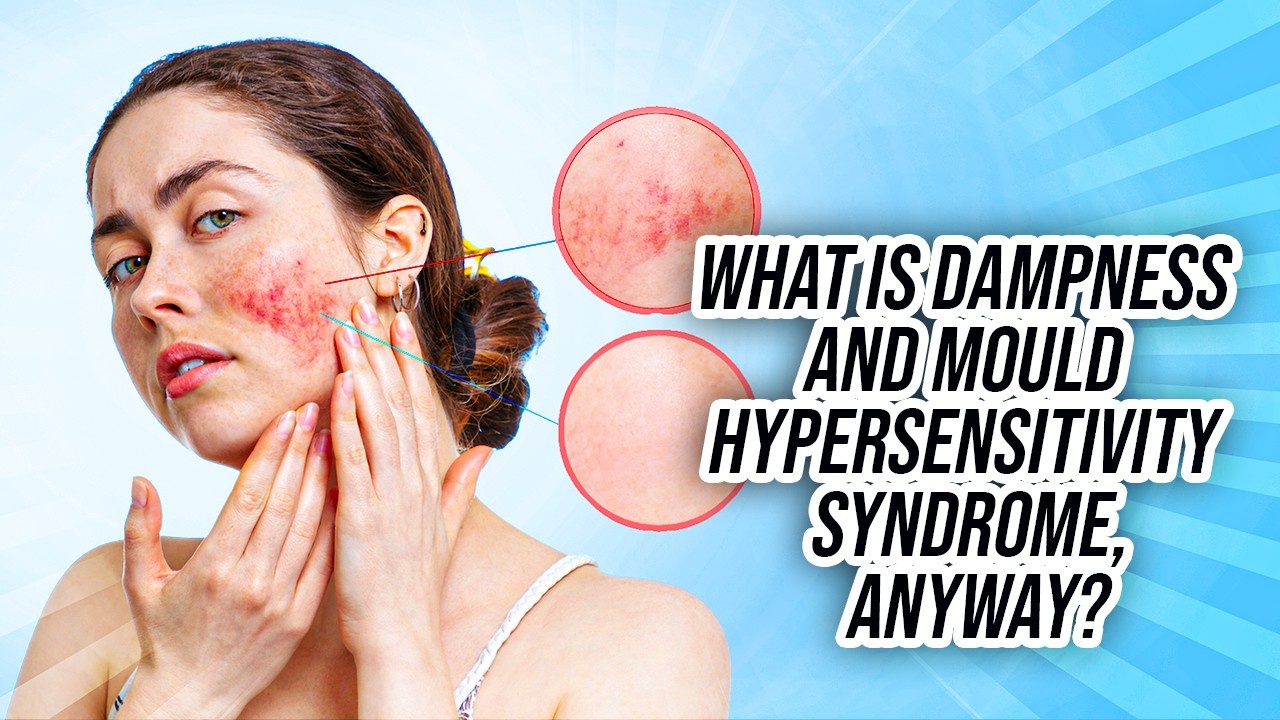
Hello, my name's Dr. Cameron Jones, and I'm an environmental microbiologist and public health scientist. And today we're going to be focusing on another aspect of water-damaged building interiors. And why is this important? Well, many people dismiss exposure to water-damaged buildings as really something trivial, and I'm here to tell you that that is not the case, and we need to take this seriously. But it's not just my word. There are many, many academic publications and clinical research showing that exposure to water-damaged building interiors has a significant negative impact on your overall health and wellbeing. And this particular show is aimed directly at those individuals who think or know that they are being exposed to water-damaged building interiors.
And I'm going to be presenting some research information which I hope you can use and take advantage of, especially if a dispute arises between, for example, yourself and a landlord or a property manager, or if you're building a new home or undertaking renovations at a property, and you suspect or find that this property is showing signs of mold. If key participants in the work say that this is irrelevant or not serious, well, you're going to love this show.
So what I wanted to set the context with is some public domain news articles. And over the last couple of weeks, in fact, any day, you can search through news stories for water damage and mold. And several weeks ago, here in Australia, on ABC News, there was a report about black mold exposure in the Aboriginal community. Now, obviously, this is a real problem area, but one of the takeaways is that you might be concluding that, well, this doesn't affect me. I'm in urban Melbourne or Sydney or Adelaide or Tasmania or Perth or Brisbane. How does poor-quality housing affect me? Well, it's not restricted to poor-quality housing. So put that image out of your mind. Water damage affects all properties at some point in the history of the property.
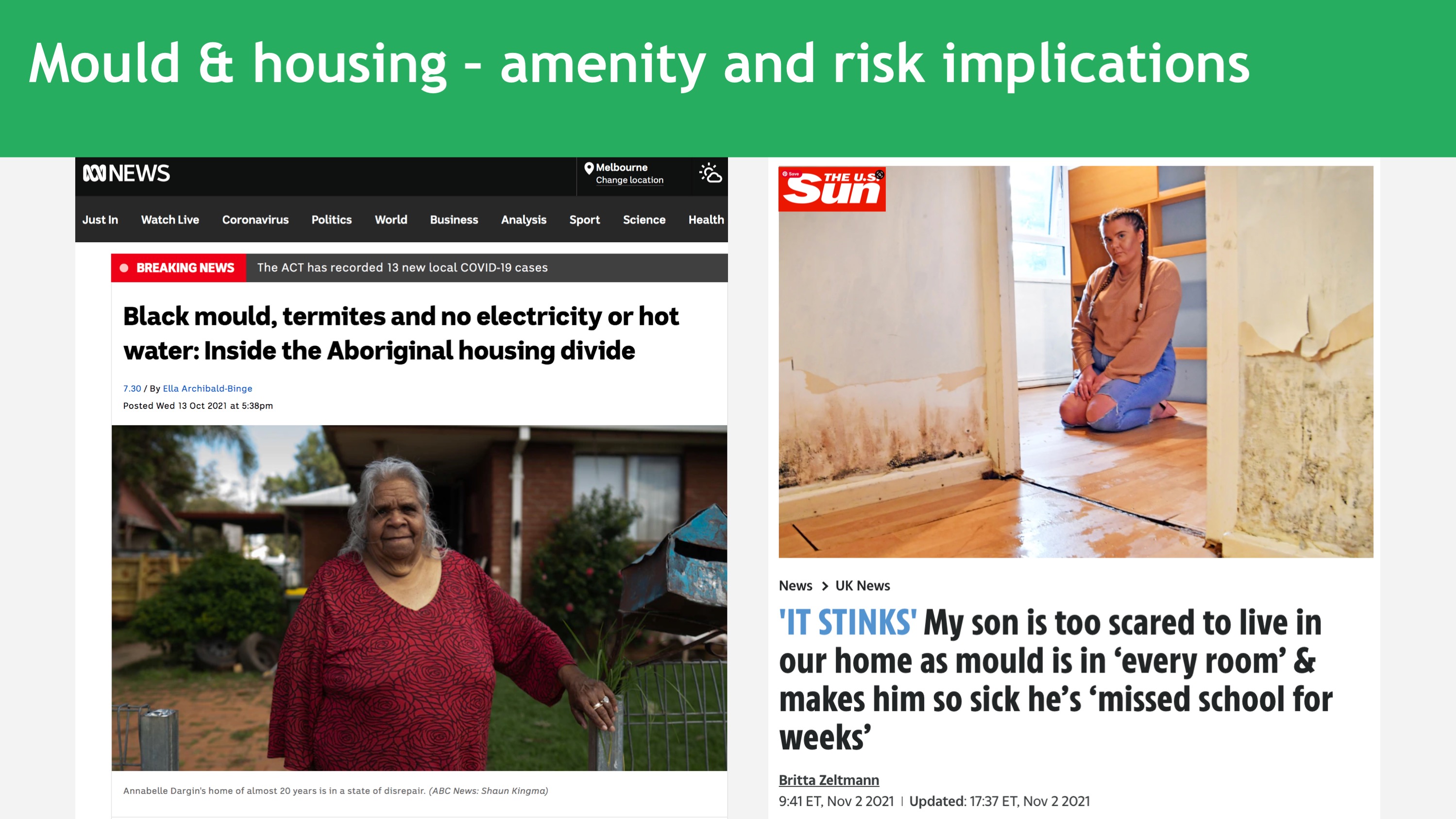
And we can also see in other news stories, the next one on the right-hand side from the US Sun, the headline is, "It stinks. My son is too scared to live in our home as mold is in every room and makes him so sick he's missed school for weeks."
So what are we going to be talking about? Well, the topic today is what is Dampness and Mold Hypersensitivity Syndrome, anyway. And to explore this, I'm going to draw your attention to this particular publication, which I'm going to allow you to download this and give you all the link for this so that you can take advantage of this publication and send it to your property manager or landlord, or include it in the premise for why you have concerns about exposure to water damage. And you might not have a building dispute. You may need to send this article to your line manager or to your boss to explain that you are having problems in a particular indoor living or working environment.
So what does this paper focus on? Essentially, we are talking about something called sick building syndrome. And sick building syndrome is an imprecise term that means that a person may feel sick inside a building or a particular part of a building, but when they leave that building, the symptoms reverse. Now, there are many causes for this, and could be noise, high airflow indoors. For example, the air conditioning or heating may be incorrectly set, or there may be a vent that vents directly onto you or into your area, meaning that that local environment is being perceived by you as less than desirable or non-ideal. There may be high levels of dust or debris brought in from urban traffic. And of course, there may be chemical odors or other odors emitted by neighboring buildings or facilities which cause the indoor working living environment to satisfy the definition of a sick building.
Now, it's very common in the research literature, and in the public domain, for the term sick building syndrome to be linked to exposure to indoor dampness. But it's not just the connection with the dampness, it's what the dampness leads to. And this is, in many cases, unchecked microbial growth and on porous and semi-porous materials as well as hard surfaces. So it's the connection between the dampness and the microorganisms that exploit those host surfaces that lead to exposure problems for individuals.
So what is the purpose of this publication? Well, the publication is looking at the clinical definitions, and in many cases, certainly with my clients, they are looking for healthcare providers or clinicians to essentially connect the dots. And this publication explains the various different definitions that may apply to you. And I'm going to be going through those today. So inside this publication, they have produced the clinician's view of the progression of Dampness and Mold Hypersensitivity Syndrome.
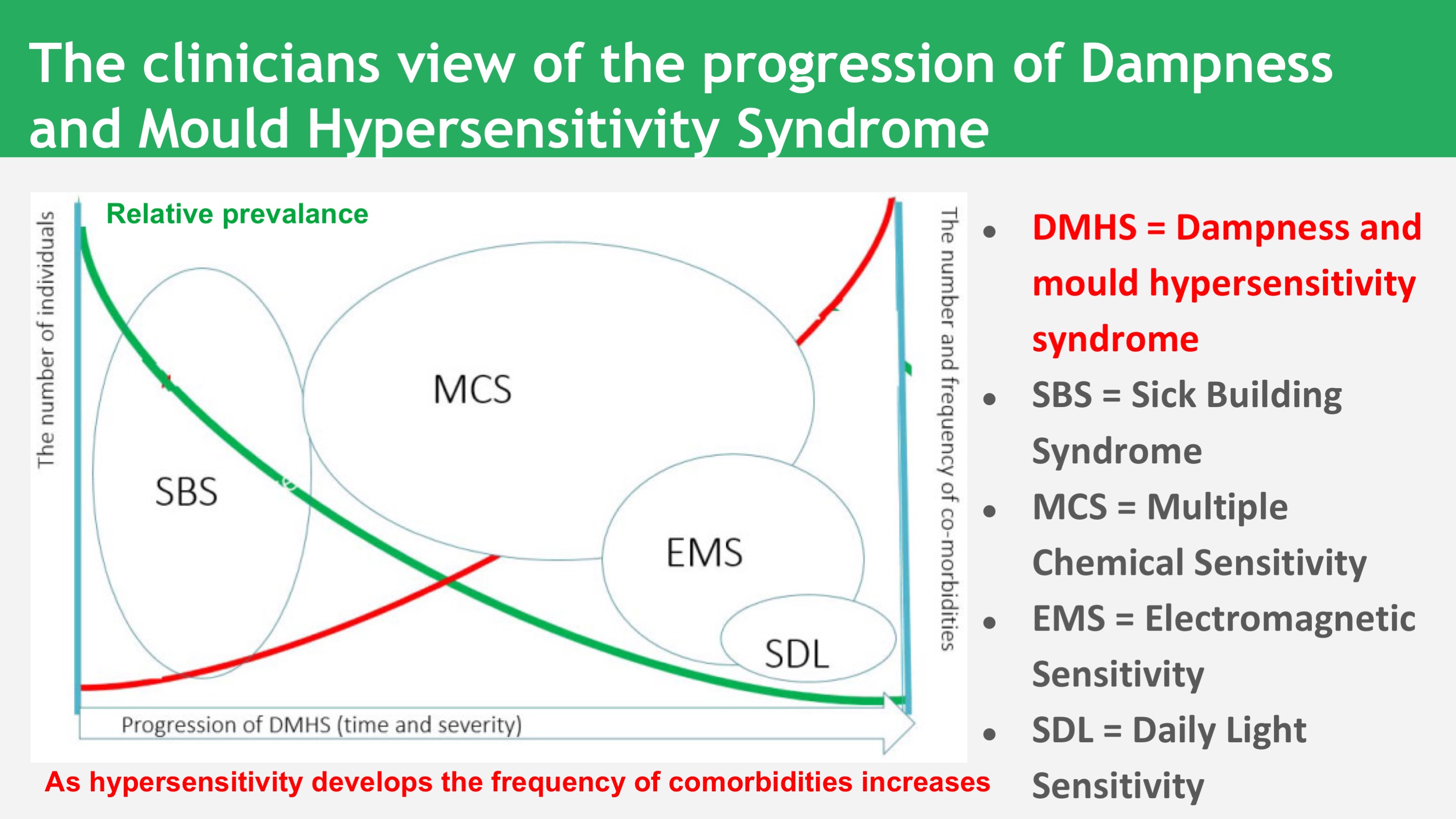
And what do these definitions mean? Well, DMHS refers to Dampness and Mold Hypersensitivity Syndrome. And this is the broad overall term, which takes into consideration a range of different clinical problems that may be observed by your healthcare practitioner. So at the beginning, and again, I should explain what the green and the red curves define. So over time, if we look at the red curve, you can see that at the beginning of the graph, there is a progression in the severity of the hypersensitivity response, the longer the person or individual is exposed to the triggering source. You can see also with the green curve that the prevalence decreases in that it is much more likely that most individuals will only experience, for example, the sick build syndrome response, meaning that when they leave the environment, their symptoms reduce, and they're okay. But over time, sick building syndrome can expand to include other problems. For example, MCS, for Multiple Chemical Sensitivity. And over time, again, individuals may further experience new types of symptoms, which include Electromagnetic Sensitivity, or even sensitivity to daily light.
Now, obviously, these are not wanted, all of these symptoms. But if they're happening to you, you need to get to the bottom, firstly of finding out what in the environment is the triggering source, and then getting a clinical diagnosis from your doctor or healthcare provider to put some sense onto your symptoms. So if we go further into this publication, we need to look at how your doctor is interpreting this. And for many people who are exposed to water-damaged buildings and high mold or bacterial concentrations indoors, you need to consider these triggers as small molecules which bind to something called chemo receptors. And these are found throughout the body, but particularly in the brain, because it is the brain which controls our perception of the outside environment or world. And it also controls, to a large extent, the signals for the immune system.
And so when you have exposure to, say, a set of mold spores or pollen grains, they may simply set up an allergic response, which you can see on the right-hand side of this schematic. And that will elicit specific Immunoglobulin E reactions, which in turn bring into play mast cells, which release histamine, which lead directly to inflammation. And this inflammation can easily affect the brain.
If we look at people who are exposed to water damage and mold over time, they can similarly become triggered by other things, not just the primary mold, but also other chemicals. And so different chemoreceptors also trigger the histamine response. And these are really neurokinins, and they too lead to inflammation. And that is a serious problem.

Now let's get away from the schematic breakdown of Immunoglobulin E type allergies or histamine release, and just let's look at what are the types of adverse events which individuals could experience beyond throat irritation, a headache, a runny nose, although those types of simple allergy symptoms, which in the main are restricted to those fortunate individuals who have short-term sick building syndrome type problems.
So if we look at the symptoms of Dampness and Mold Hypersensitivity Syndrome, we see that many indoor air environments contain high levels of mold spores and mycotoxins, many of which are neurotoxic. And this can cause what is commonly referred to as brain fog. But this term, too, is not very precise. And brain fog can also contribute to these brain type adverse symptoms such as tremors, jerking movements, tic-like motions, and even something called POTS, which is blood pressure drops causing postural tachycardia syndrome. Many people as well show signs of chronic fatigue syndrome or myalgic encephalomyelitis, this ME reaction. And so this is what happens after sick building syndrome, when it progresses into mold hypersensitivity syndrome.
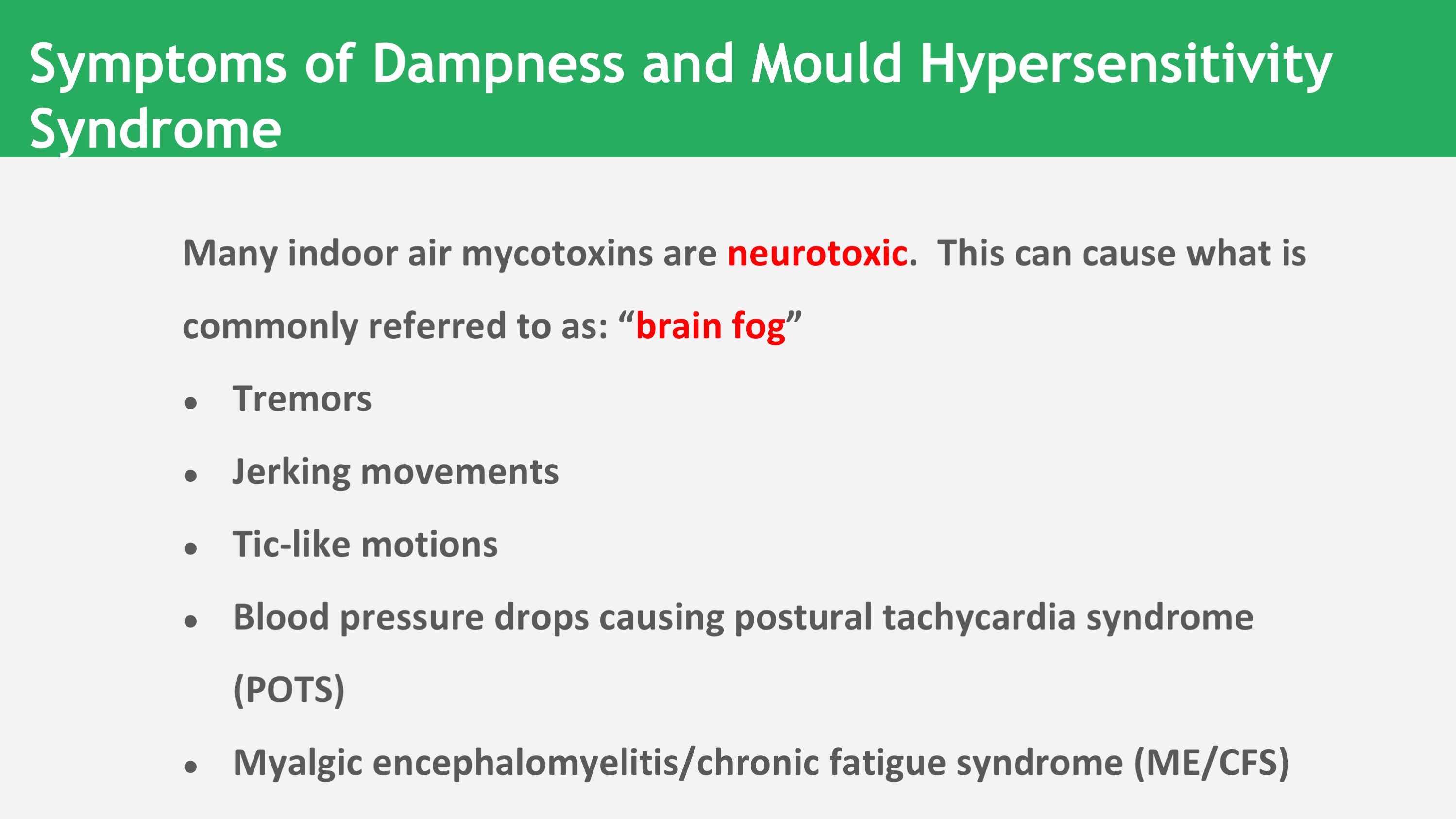
So I want to present to you a clear definition of why this happens, because this is very important for you to understand. So you can take control of the narrative, in a sense, to explain this to others.
So exposure to dampness and associated microorganisms may either inhibit or stimulate the innate and/or adaptive components of the immune system. And the net effect depends not only on the types of mycotoxins, but the types of microorganisms present in that environment and their access to the host. And the host is you. That means, how are you being affected by the building and the components, the particulate matter, or odors and mycotoxins that you are breathing in or your skin is being exposed to.
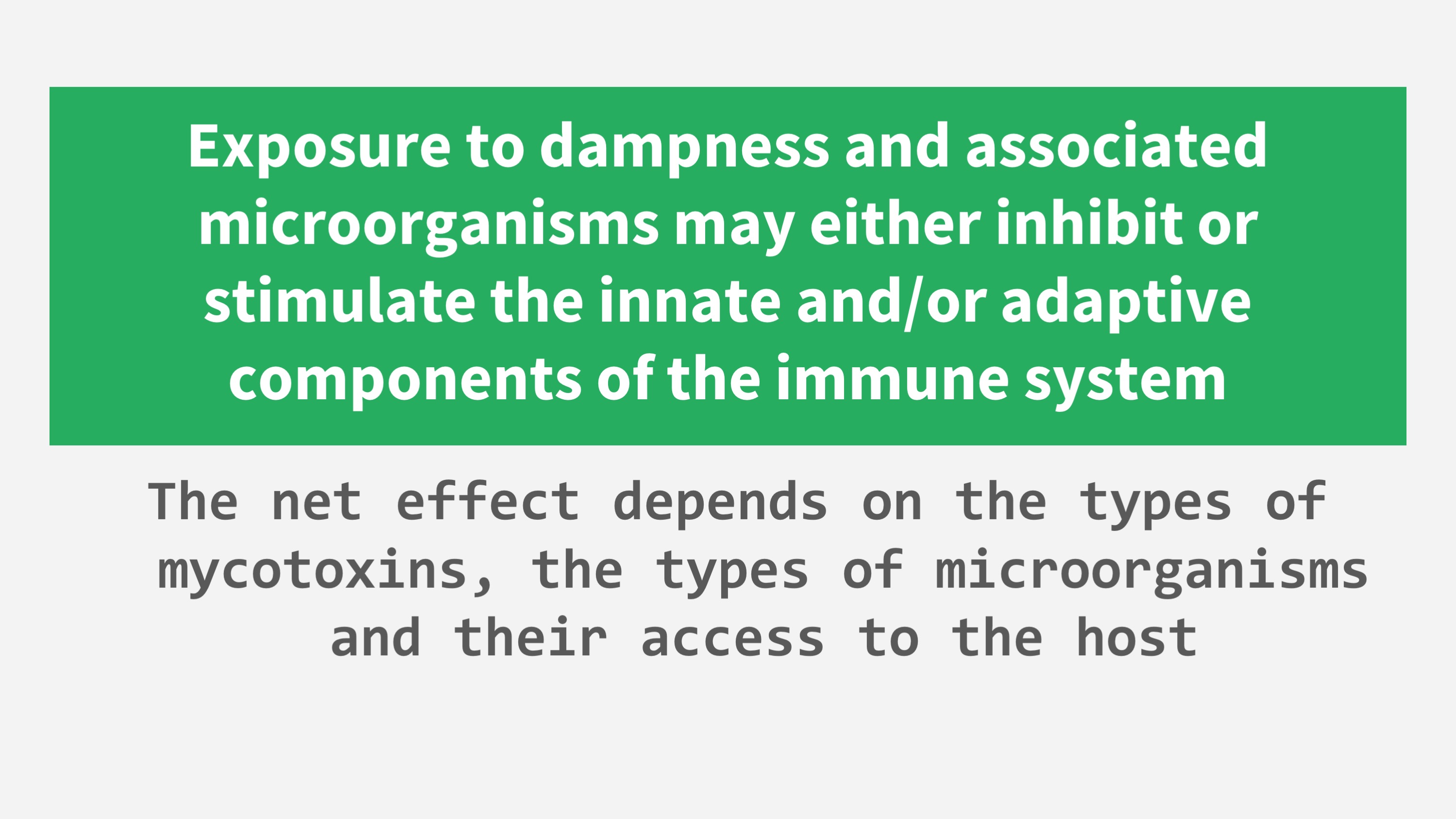
And again, in the conclusions to this article, I want to highlight a key paragraph, because it is particularly important to understand this. And the reason I am highlighting this particular paragraph is because all too often, I get calls from clients who tell me that their occupational hygienists sent by the insurer or their landlord or property manager has sent a plumber down, and they said they can't see any mold. So therefore your problem isn't serious. That is absolutely false. That is the pure definition of fake news.
And why am I saying this? Well, we have to get to what the actual scientists and clinicians have to say. And they have stated in their conclusion that "correct sampling, e.g., in clinical microbiology, when culturing microbes from, for example, wounds, pus, or infected foreign objects in the body," it's "crucial" to use those skills.
Now, why might that be important? Well, obviously, if you've got an infection, you assume that the clinician is capable of taking the relevant samples or tests to determine that that particular area or location is in fact infected. And it is no different with a water-damaged building. And this particular article states using Latin, Lege artis, sampling in the environmental microbiology and toxicology is also of utmost importance.
But why has the author chosen to premise their conclusion using this Latin terminology? Well, the definition of Lege artis means "by the rule of the art, in accordance with the approved rules of the profession or art." And why might that be important? Again, I mentioned from my personal experience that all too often unscrupulous, and I would say negligent, occupational hygienists make statements that you only need to see mold visibly for it to be a problem. Or when undertaking an inspection at your property, no evidence was found of visible mold. This completely downplays the seriousness and significance of the whole purpose of onsite assessments and inspections.
I want to conclude by saying that there are a range of standards and guidelines in the indoor air quality and water damage assessment literature online, that you can retrieve yourself, to prove the value and validity of testing the indoor air and suspect surfaces for water damage in mold and the importance of retrieving and carefully analyzing those samples to determine the extent of contamination. Relying on your eyes is negligent, in my opinion, when there are clear standards and guidelines for carrying out indoor air quality and water damage assessments. And it's in your interests to ensure that those samples are collected for a couple of reasons: to aid the remediation effort, if any is required, or to prove the hypothesis is, in fact, the environment potentially linked to an adverse health outcome, and importantly for your clinician to join the dots between your exposure history to the suspect environment and what may be a complex hypersensitivity reaction to water damage.
In any case, my name's Dr. Cameron Jones. Look forward to talking to you next week. Stay safe. Bye for now.
Watch the Livestream:
References:
Tuuminen T. The Roles of Autoimmunity and Biotoxicosis in Sick Building Syndrome as a "Starting Point" for Irreversible Dampness and Mold Hypersensitivity Syndrome. Antibodies (Basel). 2020 Jun 22;9(2):26. doi: 10.3390/antib9020026. PMID: 32580407; PMCID: PMC7345570.
'IT STINKS' My son is too scared to live in our home as mould is in ‘every room’ & makes him so sick he’s ‘missed school for weeks’
https://www.the-sun.com/news/3981683/son-scared-home-mould-missed-school/
Black mould, termites and no electricity or hot water: Inside the Aboriginal housing divide
https://www.abc.net.au/news/2021-10-13/condobolin-aboriginal-tenants-houses-mould-termite-faults/100530342

